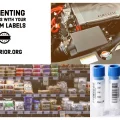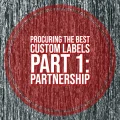 The Final Installment in a Series on New Labeling Requirements That May Impact Your Business
The Final Installment in a Series on New Labeling Requirements That May Impact Your Business
In my previous two posts, I talked about new label regulations designed to make things better and safer for consumers. One involved new provisions for nutrition labels that help people make more informed food decisions about the foods they eat. In the other, I discussed new requirements for produce traceability from grower to retailer, enabling quicker and more effective response to any potential issue of contamination or health risks.
Today, I’d like to touch upon a third area in which new labeling standards are being implemented: the manufacture, distribution and shipping of chemicals. The new protocols will result in enhanced safety for employees involved at every level of the process and for the general public. So if they affect your business, it is critical that you are aware of them and move swiftly to achieve compliance.
The International Impact of “GHS”
The standard is referred to as GHS – the “Globally Harmonized System” of Classification and Labeling of Chemicals. It was created by the United Nations and is maintained throughout the world in order to ensure that chemicals are quickly and clearly recognized and identified through consistent pattern of important information displayed clearly on the containers bearing them.
The need for such a system is obvious, with international commerce putting workers of many nationalities in an almost unlimited number of destinations directly at risk of exposure to dangerous chemicals. The potential hazards of improper handling have dramatic implications to the general public as well, as a toxic or dangerous chemical could spread to or contaminate a great many people in nearby areas.
Each Label is a Lifeline
GHS provisions begin with a durable label that prominently identifies the chemical or product clearly on its container in a large, visible type font. But it goes far beyond that, also requiring the following information to be added to that label:·
- A signal word may be required to help disclose the severity of the hazard posed by the chemical, with “danger” signifying more severe hazards, and “warning” denoting a less severe level of threat.
- A hazard statement that describes the exact nature and degree of the hazard posed, such as “Highly flammable liquid and vapor. Causes serious eye irritation.” or “May cause drowsiness or dizziness.”
- A precautionary statement that includes standardized phrases that describe recommended measures to be taken in order to minimize or prevent adverse effects that result from exposure to the chemical, or its improper handling or storage. This information, in slightly smaller type, contains phrases such as “Keep away from sparks, heat, open flame or hot surfaces.” or “May be harmful if inhaled. Causes respiratory tract infection.”
- The supplier identification that clearly presents the name, address, and phone number of the manufacturer, importer, or other party responsible for the presence of the chemical being at the site.
Safety Beyond Words
While the information I’ve already discussed is certainly substantial, the GHS mandates go beyond even that, calling for pictograms on each label. These are large, bold graphics that convey critical information at a glance. Each of these visual components starts with a black symbol depicting the type of hazard (such as flame for a flammable product) presented on a white background and enclosed by a red geometrical border to make it stand out.
These new rules are already in effect for chemical manufacturers. Distributors shipping these chemicals must use GHS-compliant labels on the containers starting on December 1, 2015. So clearly, there is little time to lose.
Superior Business Solutions provides full-service label printing and design capabilities. Part of that service is helping you comply with these or any label standards or requirements that apply in your industry or situation.
If you have a question or would simply like more information on the responsibilities your business may have in this area, just give us a call. We will move quickly to protect your business, and the many others who are depending on you to label your products or packaging accurately and appropriately, as required.



